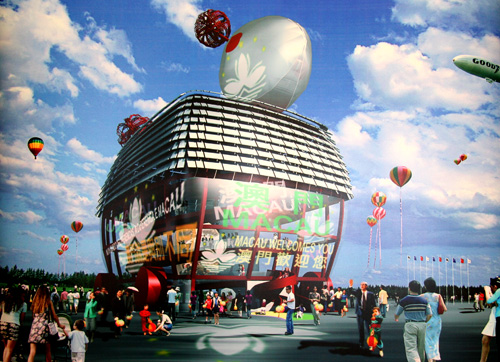|
|


ADVERTISEMENT
Buy Your own advertising
spaces!
.
Download Adobe Acrobat Reader to open [PDF] files.
Recent Visitors
Macao Pavilion: A Mix of Cultures
2009. 14 September
"The outer design was based on the design principles of the traditional rabbit lantern in south China," Carlos Alberto dos Santos Marreiros, designer of the Macao Pavilion, told the Oriental Morning Post. Fluorescent panels used for the main body enable the "rabbit" to radiate various bright colors. by Li Yuzhu
by Li Yuzhu
(bjreview.com)
The Macao Pavilion is under rapid construction and has taken an initial shape, according to the website for the Shanghai 2010 Expo. The seven-story pavilion sits under the China National Pavilion and is shaped like a "rabbit lantern."
The designer noted that in Chinese fairytales the rabbit is smart and amiable, symbolizing peace and harmony. "It is very reasonable to use the rabbit image for the pavilion, because rabbits have since ancient times been a mascot for people both in China and abroad," he said. "It indicates that Macao, though very small, focuses on cultural multiplicity."
Marreiros, 52, is a Portuguese born and living in Macao. The idea to design the pavilion in the form of a rabbit lantern came from his childhood memories as well as those of his daughter.
Covering an area of 1,000 square meters, the main building of the pavilion is 19.99 meters high, symbolizing the return of Macao to Chinese Government rule in December 1999.
<>To save water, the whole pavilion is made of glass and steel materials that can be recycled after the end of the Expo. The pavilion's interior design showcases new and high technologies and an eco-friendly environment.The roof and lower part of the pavilion are enveloped in transparent glass that insulates heat and reduces the noise level by 20 to 60 decibels. Visitors outside will be able to see interior displays through the glass.
The upper part of the pavilion is installed with a solar power supply system to provide all the electricity the pavilion needs. Solar panels will both generate power and provide shade from sunlight. They can be turned from 30 degrees to 45 degrees as the sun moves throughout the day.
All the materials used in the pavilion are environmentally friendly, including those for building and decoration, the balloons used as the head and tail of the rabbit lantern, and the multimedia equipment. The pavilion will also be equipped with a rain collection system and sewage disposal system.
Multimedia technologies will be used to showcase traditional Chinese calligraphy and painting, many attractions in terms of society, economy, culture and tourism, and special traits in terms of housing and food. On top of the pavilion, a film will be screened on the roof, and a small slide will lead children to the exit.
The most eye-catching part of the pavilion is the exhibition corridor, a spiral ramp that has no barriers, Marreiros said. It is a major passageway with an area of 582 square meters. It will take visitors from the ground floor to the top of the building, as well as serve as an exit for visitors.
Along the two sides of the ramp, visitors will see displays showcasing the past, present and future of Macao, as well as its unique blend of Eastern and Western history and culture.
Source: www.bjreview.com

